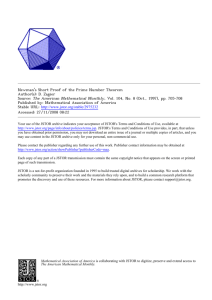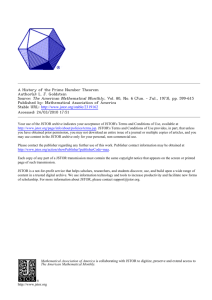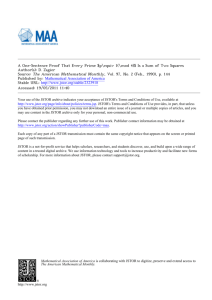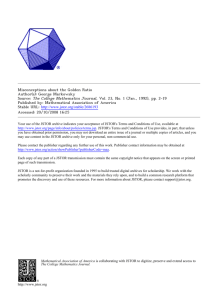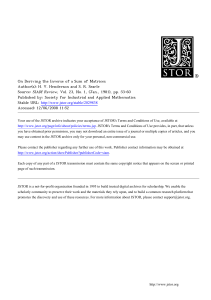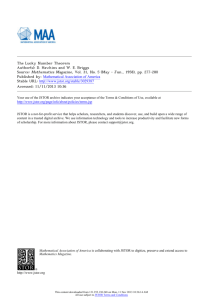A Visual Display of Some Properties of the Distribution of Primes
advertisement
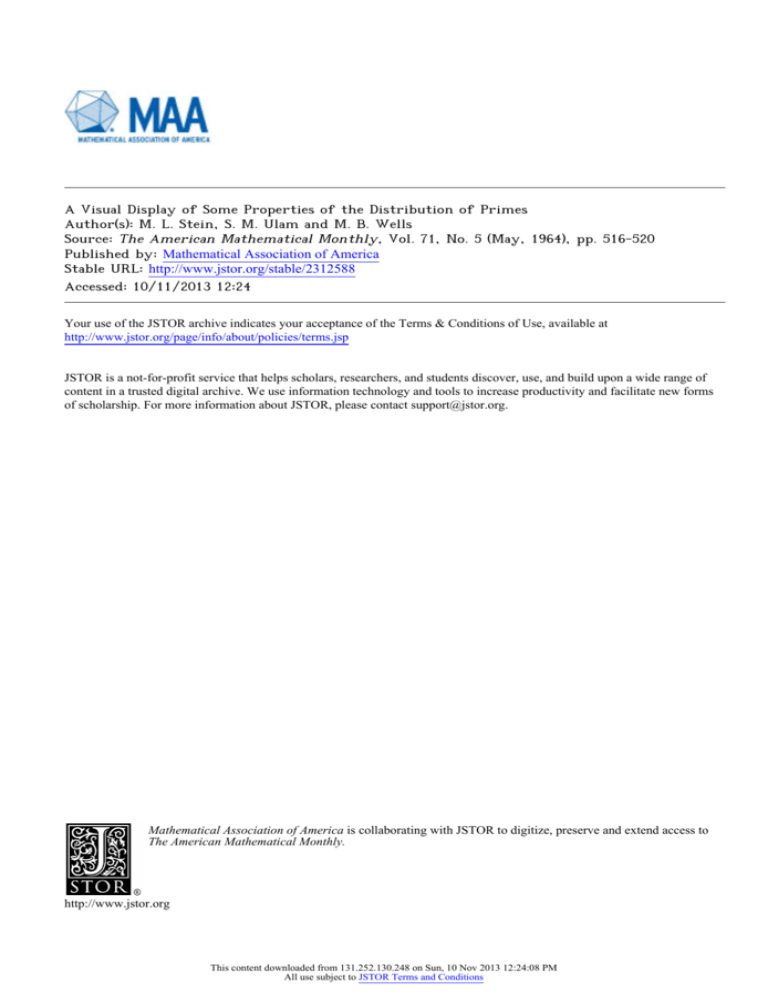
A Visual Display of Some Properties of the Distribution of Primes
Author(s): M. L. Stein, S. M. Ulam and M. B. Wells
Source: The American Mathematical Monthly, Vol. 71, No. 5 (May, 1964), pp. 516-520
Published by: Mathematical Association of America
Stable URL: http://www.jstor.org/stable/2312588 .
Accessed: 10/11/2013 12:24
Your use of the JSTOR archive indicates your acceptance of the Terms & Conditions of Use, available at .
http://www.jstor.org/page/info/about/policies/terms.jsp
.
JSTOR is a not-for-profit service that helps scholars, researchers, and students discover, use, and build upon a wide range of
content in a trusted digital archive. We use information technology and tools to increase productivity and facilitate new forms
of scholarship. For more information about JSTOR, please contact support@jstor.org.
.
Mathematical Association of America is collaborating with JSTOR to digitize, preserve and extend access to
The American Mathematical Monthly.
http://www.jstor.org
This content downloaded from 131.252.130.248 on Sun, 10 Nov 2013 12:24:08 PM
All use subject to JSTOR Terms and Conditions
516
MATHEMATICAL NOTES
[May
1} when
, a.)) = i} = {O, 1, *.*.*, m(n1)a.)) f((aj, *
, m-1. Note that there is at least one Latin chessboard, e.g.:
* **
* * * +a.
(mod m). It can be easily shown that we
f((al,
a.)) =a,+a2+
minimizeconnectednessparallel to the i-axis by distributingthe points of S as
evenly as possible among the mn-1pencilsparallel to the i-axis. The assignments
, an)) are exactly those ash((al, * * -, aj)) = mnf((al, * * *, a)) +g((al,
signmentswhich do this forall i= 1, * * *, n.
- 1)m2-1.
The maximum value attained is (1/6)n(m2
Thus the minimum
assignmentis 1/nththe average assignment,asymptoticallyas m or n gets large,
whereas the average assignmentis (m/m+l)th of the maximumassignmentas
m gets large.
{g((a,,
i=O,
Reference
1. LawrenceHarper,Jr.,Optimalassignments
of numbersto vertices,J. Soc. Indust.Appl.
Math.,to appear.
This paperwas one oftwowinnersofthefirstE. T. Bell prizeforundergraduate
researchin
mathematics
at the CaliforniaInstituteof Technology.The problemaroseat theJetPropulsion
Laboratory,
whichthe Instituteoperateswithsupportfromthe NationalAeronautics
and Space
Administration.
Editorial Note. In this MONTHLY 70 (1963) 706-711, A. A. Blank asked
whether7r/8may be the minimalarea of a star-shapeddomain withinwhich a
unit segmentcan be turnedthrough3600. C. S. Ogilvy has called attentionto a
demonstrationby R. J. Walker (Pi Mu Epsilon Journal,1 (1952) 275) that a
unit segment can be turned through3600 in a five-pointedstar with area approximatelythree quarters of xr/8.
MATHEMATICAL
EDITED BY
NOTES
J. H. CuRTISS,Universityof Miami
shouldbesenttoJ. H. Curtiss,
Materialforthisdepartment
University
ofMiami, CoralGables46, Florida
A VISUAL DISPLAY OF SOME PROPERTIES OF THE DISTRIBUTION OF PRIMES
M. L. STEIN, S. M. ULAM,ANDM. B. WELLS, Universityof California,
Los AlamosScientific
Los Alamos,New Mexico
Laboratory,
Suppose we numberthe lattice points in the plane by a single sequence, e.g.
Fig. 1 by startingat (0, 0) and proceedingcounterclockwisein a spiral so that
(0, 0)-1, (1, O)->2, (1, 1)->3, (O, 1)->4, (-1, 1)-?5, (-1, O)--6, (-1, -1)-?7,
(O, -1)-->8, (1, -1)->9, (2, -1)-*10, (2, 0)-11, (2, 1)- 12, (2, 2)- 13, etc.
This content downloaded from 131.252.130.248 on Sun, 10 Nov 2013 12:24:08 PM
All use subject to JSTOR Terms and Conditions
1964]
MATHEMATICAL NOTES
517
Consider the set P of those lattice points whose single index becomes a prime.
Under our correspondence,points of P located on straight lines have indices
which ultimatelyconsist of values of a quadratic form.This is easily seen because the thirddifferencesbetween neighboringpoints on a straightline are 0
and aftera finitenumberof indices which vary linearlyhave been passed, the
progressionbecomes trulyquadratic.
FIG. 1
The set P appears to exhibit a strongly nonrandom appearance (i.e. a
differentappearance fromrandomlychosen sets whose densities are like those
of primes; that is, asymptoticallylog n/n). This is due, of course, to the fact
that some linescorrespondingto quadratic formswhichare factorableare devoid
of primes; some other quadratic formsare rich in primes.A glance at a picture
showingthe set P reveals many such lines. It is a propertyof the visual brain
which allows one to discover such lines at once and also notice many other
peculiaritiesof distributionof points in two dimensions.In a visualization of a
one-dimensionalsequence this is not so much the case. (Perhaps an acoustic
interpretationwould be more suggestive?)
In addition to the well-knownEuler form: y2+y+41, one could observe
instantlymanyotherprime-richforms.One line ratherprominentin Fig. 1 in the
lower half of the picturehas numbersof the form4x2+170x+1847; as pointed
out by the referee,this is reducible into Euler's formby putting y=2x+42.
(Under the enumerationabove, the horizontal,verticalor diagonal straightlines
correspondto quadratic forms,which have a leading term 4x2.) We have tried
This content downloaded from 131.252.130.248 on Sun, 10 Nov 2013 12:24:08 PM
All use subject to JSTOR Terms and Conditions
518
[May
MATHEMATICAL NOTES
other "Peano numberings"of the lattice points. For example, (Fig. 2) forlattice
points in the positive quadrant:
(0,0) -1,
(0, 2)
(0,1)
5, (1, 2)
>2, (1, 1) >3, (11O0)-4
>
6; (2, 2)
7, (2, 1) -
8, (2, 0)
FIG. 2
FIG. 3
This content downloaded from 131.252.130.248 on Sun, 10 Nov 2013 12:24:08 PM
All use subject to JSTOR Terms and Conditions
9, etc.
19641
MATHEMATICAL
NOTES
519
The successive points on the principallines will ultimatelyhave coordinates
given by quadratic formswith leading term 1*x2.Or, (Fig. 3) forpoints in the
upper half plane:
(0, 0) 1, (- 1,0) -*2, (- 1,1) >-+3,(0, 1) 4
(1, 1)-5,
(1,0)-*6, (-2,O0)--7, (-2, 1)-+8
(-2,2)9, (-1,2) ---10, (0,2)->11, (1,2)-12
(2, 2)
13, (2,1) -> 14, (2, 0) -+ 15 and so on.
There, the principalstraightlines correspondto formswith the term 2x2.
The obvious questions,e.g.: Is the distributionof pointsof P asymptotically
symmetricin every angle fromthe origin?Are there lines containinginfinitely
many primes?What is the asymptoticdensityof points on lines (e.g. are there
pairs of nonfactorablelines with different
asymptoticdensities)? etc. seem to be
hardly answerable with the presentknowledgeof the distributionof primes.
FIG. 4
We have observed many nonfactorablebut, so to say, "almost factorable"
lines, i.e. lines extremelypoor in primes.We should add, as a curiosity,that as
we displayedsimilarlythe set L of luckynumbers(see [I ]), in (Fig. 4) (the numberingof lattice points in this case is by a "discontinuousspiral," i.e. as in (Fig.
3) but goingthroughboth halfplanes); it appears again that thereis a great deal
of "structure"; in particular,some of the principal lines are manifest.This is
much more surprising,of course, since there is no obvious multiplicativepropertyof the set of luckies and no relationwhichis rigorousbetween the divisibility of quadratic formsand the definitionof the sieve determiningthe lucky
numbers.
This content downloaded from 131.252.130.248 on Sun, 10 Nov 2013 12:24:08 PM
All use subject to JSTOR Terms and Conditions
520
[May
MATHEMATICAL NOTES
The firstobservationof the propertiesof the P set was made on a few hundred points by hand. On the electronic computing machine "Maniac II" in
Los Alamos we have been able to use a scope attached to the machine, which
can display up to 65,000 points obtained as a resultof calculation. This is then
photographedand our pictures show a few of the results. We have magnetic
tapes containing tables of primes up to ninety million. Afterdiscoveringthe
quadratic formswhichseem to be richin primesup to n = 100,000or so, we then
investigatedprimesup to ten millionforsuch forms(see [2 ]). A fewof the statisticsare given below:
For primesin the Euler formn=x2+x+41 we found the ratio r of these to
all numbersof this formn up to 10,000,000to be r=.475
(1) For the formn=4x2+170x+1847 thereare 727 primesin the first1560
fornumbersof this form(1 < n < 10,000,000)(r= .466).
(2) For n =4X2+4x+59 yields r = .437*.
(3) For n=2x2+4x+117 (the "rare" form)r=.050
(A reasonforrarityis that forno primep < 29 is divisibilityby p excluded)
(4) The quadratic formn=x2+x+1
is rich in "luckies." Up to numbers
n-300,000 r=.29
This workwas performed
undertheauspicesoftheU. S. AtomicEnergyCommission.
References
1. V. Gardiner,R. Lazarus,N. Metropolis,and S. Ulam, On certainsequencesof integers
definedby sieves,Math. Mag., 29 (1956) 117-122.
2. Cf. Beeger,NieuwArch.Wisk.,20 (1939) 50.
ON THE MEAN VALUES OF INTEGRAL FUNCTIONS AND THEIR DERIVATIVES
DEFINED BY DIRICHLET SERIES
J. S. GUPTA,IndianInstituteofTechnology,
Kanpur,India
1. Consider the Dirichlet series f(s) =
s= o+it and
??
limnxXn=
(1.1)
limsup
nl
oo
Icatesn, where X.+1>Xnw,
Xl
0,
log n
--=0.
A
Let o-,and (7a be the abscissa of convergenceand the abscissa of absolute convergence,respectively,off(s). Let o- = oo then 0Ja will also be infinite,since accordingto a known result ([1], p. 4) a Dirichletseries which satisfies(1.1) has
its abscissa of convergenceequal to its abscissa of absolute convergenceand
therefore
f(s) representsan integralfunction.
We definethe mean values off(s) as
Ir)=I'(0,J)
=
lim
_J If(o+ it) Jrdt,
T-, 2T _?
1
T
This content downloaded from 131.252.130.248 on Sun, 10 Nov 2013 12:24:08 PM
All use subject to JSTOR Terms and Conditions
(r>
O),

